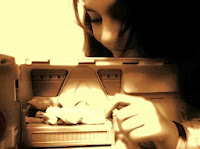"The trick, intelligently applied, today allows us to make visible the supernatural, the imaginary, even the impossible." - GM
These are the famous words of the French Film-maker Georges Melies, who is commonly referred to as 'A Magician in the Editing Evolution of Film' and the first Cinemagician. Melies is considered to be the father of special effects, including: the simple fade in/fade out, dissolve, stop edit, double exposure and stop motion animation. He never once moved his camera in any of his 500+ films, and was the first to incorporate photography and narratives - in short he was a true auteur.
The pictures below give examples of a Double Exposure - which I unknowingly used in a Photography Project for College. The far left is a still from Melies' 1901 film 'The Man with the Rubber Head'. See here: http://www.youtube.com/watch?v=DDmFxPpwlcQ
The far right is a photo edit I made using Paint and Microsoft Word based on 'The Borrowers'.
.jpg)
One of my favourite techniques that Georges Melies uses is the Stop-Edit (otherwise known as a Jump-cut), which enables an object to appear, disappear and jump through space as if by magic. You may think this is a cheap trick, but this technique is used in modern day films to both entertain and terrify. In fear of it turning into a cliche, and an editing mish-mash, Guy Ritchie's 'Snatch' has a noticeable amount of jump-cuts, but somehow - though it may seem disjointed - the subtlety of the effect tricks the mind into believing that the image flows perfectly. See: Snatch opening titles A similar but more refined technique is used by Ritchie in his Sherlock films - more specifically during the fight scenes. See: Sherlock Holmes: A Game of Shadows"I must say, to my great regret, the cheapest tricks have the greatest impact." - GM
Below is my amateur attempt at creating a stop-edit film in the style of Georges Melies using a Canon IXUS 115 HS, Windows Movie Maker and Microsoft Word (how primitive). The final touches were added using Adobe Premier Elements 11.
For more information regarding Georges Melies, please see the following link which covers his life story, his films and how to recreate some of his techniques: Georges Melies: The Father of Special Effects
You can also see the above film on Vimeo: https://vimeo.com/77423245
Comments
Post a Comment